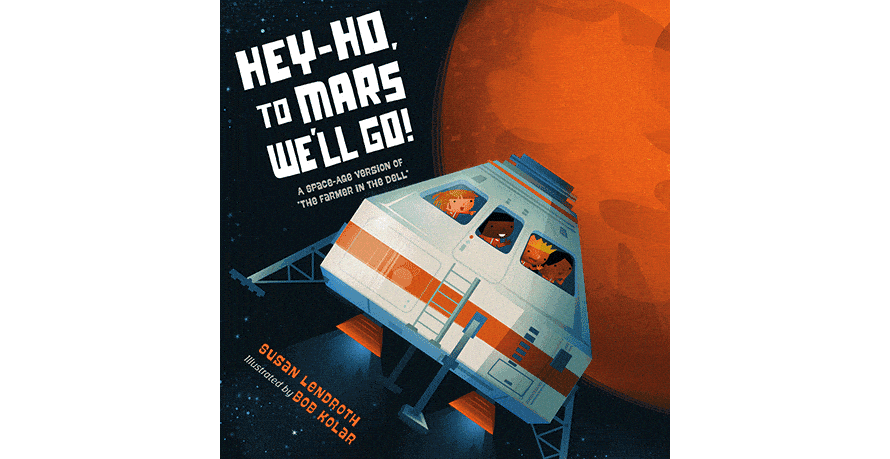Category: Children’s Books
Reviewed by: Peter Spasov
Title: Hey-Ho to Mars We’ll Go!
Author: Susan Lendroth
Illustrator: Bob Kolar
NSS Amazon link for this book
Ages: 4 to 8
Format: Hardcover, paperback, Kindle
Pages: 144
Publisher: Charlesbridge
Date: February 2019
Retail Price: $8.99/$9.99
ISBN: 978-1623541002
Children love nursery rhymes and Hey-Ho to Mars We’ll Go is a captivating version of the classic, The Farmer in the Dell. Parents or other caregivers may sing or simply read the lyrics.
Upon launching into this adventure world, one sees colors of primarily black and orange, adding a distinctive Martian look to the work. Illustrator Bob Kolar portrays the environment and technology in a charming and authentic way. Likewise, author Susan Lendroth writes with direct, yet appealing allure.
This is an epic of four young astronauts beginning with a roaring launch plus a simple explanation about gravity. A child will discover the need for supplies, some simple spaceship logistics, plus the fact one must bring one’s own air to breathe. And don’t forget the fun of diving through the hatch while in freefall. The story includes a nod to both planets, Earth and Mars. There is more fun with tinges of seriousness while voyaging without gravity. The creators employ a clever technique to illustrate how different it is. Some of the pages are upside down or sideways; hence the reader will need to physically turn the book around, exactly like the situation in space.
Children will also see how different it is to clean, eat and sleep. We see how they exercise (and why it’s important) and grow food with hydroponics. It is a wonderful way to show them the world can be much stranger than everyday experience. If there is a way to trigger an interest in science, this is certainly one way to accomplish this.
Eventually we come to the touchdown on Mars. Here a child will learn about how Mars differs from Earth, how Earth appears from Mars—and how they can actually see Mars in the night sky while on Earth. While setting forth to explore, the young astronauts discover interesting facts such as canyons deeper than any on Earth and a mountain three times taller than Mount Everest.
A noteworthy feature is how the text includes generic parenting lessons embedded within the exotics of space travel. Raising children involves encouraging them to eat healthy and to exercise often, meaning to go out and play in contrast to passively watching TV and such. Such lessons often appear throughout the book. One poignant point combining fun and realism is a section about spending months inside a spaceship as akin to being stuck indoors on rainy days, yet this can still be positively fun: read, play games, watch movies and daydream of adventures. Our youthful enthusiastic crew is also diverse racially and by gender, another subject the creators implicitly convey.
The Farmer in the Dell has its own intriguing history—read about it on Wikipedia. This work is a worthy addition to its storied pedigree, albeit now futuristic compared to the earlier agrarian versions, yet the Lendroth/Kolar work maintains its agricultural heritage via the importance of growing food during long space missions.
As an introduction to STEAM (science, technology, engineering, art, mathematics), the book is a valued addition to any family library. Public libraries should also stock it. The interested guardian can download an activity guide and answer key from the publisher’s website. These activities include fill-in-the-blanks, word search puzzle, a spacecraft design exercise, and cut outs for a build-your-own bingo game.
Lendroth has authored other children’s non-fiction as well as generally advocating interplanetary exploration. The book employs large text for the lyrics and smaller for background material written in a direct simple way. A published robotic-spaceflight engineer is acknowledged for the accuracy of both text and illustrations.
This playful story exposes children to a realistic yet also enchanting world of make believe without invoking mystical spells and incantations. It is magical in a scientific way.
© 2019 Peter Spasov
Please use the NSS Amazon Link for all your book and other purchases. It helps NSS and does not cost you a cent! Bookmark this link for ALL your Amazon shopping!



















